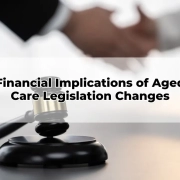Understanding Aged Care Bonds (RADs) and Their Benefits
Table of Contents
TogglePlanning for aged care is an essential aspect of financial stability in later life. As people age, the need for comprehensive and affordable care becomes paramount. Effective financial planning ensures that individuals can afford the care they need without compromising their financial security.
Overview of Refundable Accommodation Deposits (RAD)
Refundable Accommodation Deposits (RADs) are a key component of aged care financing in Australia. They provide a means for securing accommodation in aged care facilities, ensuring that residents have access to quality care and living arrangements. Understanding RADs is crucial for making informed decisions about aged care.
What are Aged Care Bonds?
Definition and Purpose
Aged care bonds, also known as RADs, are lump-sum payments made to aged care facilities. These deposits secure a resident’s place and cover the cost of accommodation. The primary purpose of RADs is to provide financial security to aged care providers while offering residents peace of mind.
Historical Context
RADs were introduced as part of the Australian government’s reforms to make aged care more sustainable and equitable. They replaced the older system of accommodation bonds, streamlining the process and providing clearer benefits and protections for residents.
How RADs Work
Payment Options
RADs can be paid as a full lump sum, in periodic payments (known as Daily Accommodation Payments or DAPs), or as a combination of both. This flexibility allows residents to choose a payment method that best suits their financial situation.
Refundability of RADs
One of the key benefits of RADs is their refundable nature. Upon leaving the aged care facility, the RAD is refunded to the resident or their estate, minus any agreed-upon deductions for care services or maintenance.
Determining RAD Amounts
Factors Influencing RAD Costs
The cost of a RAD is influenced by various factors, including the location and quality of the aged care facility, the size and features of the accommodation, and the level of demand in the area. Higher quality facilities in desirable locations typically command higher RADs.
Government Regulations
Government regulations ensure that RADs are set at a reasonable level and provide protections for residents. Facilities must publish their RAD prices and cannot charge more than what is advertised. Additionally, there are caps on the maximum amount that can be charged without government approval.
Benefits of RADs
Security and Assurance
RADs offer security for both residents and aged care providers. For residents, a RAD guarantees a place in the facility, while for providers, it offers a stable source of funding for operational costs and facility maintenance.
Potential for Financial Growth
In some cases, RADs can be invested by the aged care provider, potentially generating financial returns. These returns can be used to improve the quality of care and facilities, benefiting all residents.
Payment Structures
Full Payment
Paying the RAD in full as a lump sum can be advantageous as it eliminates ongoing accommodation costs. This option provides clarity and simplicity in financial planning.
Combination of RAD and Daily Accommodation Payment (DAP)
A combination of RAD and DAP allows residents to split the cost, paying part of the accommodation fee upfront and the remainder as daily payments. This option offers flexibility and can be tailored to individual financial situations.
Financial Considerations
Impact on Pension Eligibility
Paying a RAD can affect pension eligibility, as it is considered an exempt asset under the means test for the Age Pension. This can potentially increase pension payments, providing additional financial support.
Tax Implications
RADs are generally not subject to tax, either when paid or refunded. However, it’s essential to understand the specific tax implications of any income generated from investments used to pay the RAD.
Managing RAD Payments
Using Superannuation
Superannuation funds can be an excellent source for paying a RAD. Drawing from superannuation can provide the necessary funds without significantly impacting other financial assets.
Downsizing and Property Sales
Selling a property and downsizing can free up capital to pay the RAD. This strategy not only provides the required funds but also simplifies living arrangements, reducing maintenance responsibilities.
Comparing RADs with Other Payment Options
RAD vs. DAP
Choosing between a RAD and a DAP depends on individual financial circumstances. While a RAD eliminates ongoing accommodation costs, a DAP may be more manageable for those who prefer not to deplete their savings.
RAD vs. Periodic Payments
Periodic payments offer an alternative to the traditional RAD and DAP options. These payments can be structured to suit individual financial situations, providing flexibility in managing aged care costs.
Legal Aspects
Rights and Obligations of Residents
Residents have specific rights and obligations under the terms of their RAD agreement. These include the right to receive a refund, the obligation to maintain the accommodation, and the terms under which deductions can be made.
Contractual Agreements
Understanding the contractual agreements associated with RADs is crucial. These agreements outline the terms of payment, refund conditions, and any deductions that may apply. It’s essential to review these agreements carefully before committing to a RAD.
Case Studies
Real-Life Examples
Real-life examples illustrate the benefits and challenges of paying a RAD. These case studies provide valuable insights into how different financial strategies can impact the affordability and sustainability of aged care.
Lessons Learned
Learning from the experiences of others can help individuals make informed decisions about their aged care financing. These lessons highlight the importance of early planning, flexibility, and professional advice.
Seeking Professional Advice
Role of Financial Advisers
Financial advisers play a critical role in helping individuals navigate the complexities of aged care financing. They provide expert guidance on the best strategies for paying a RAD and managing other financial considerations.
Finding the Right Adviser
Choosing the right financial adviser involves considering their qualifications, experience, and understanding of aged care issues. A trusted adviser can provide personalised advice, ensuring that individuals make informed and confident decisions about their aged care finances.
Understanding and effectively managing Refundable Accommodation Deposits (RADs) is essential for securing quality aged care without compromising financial stability. By exploring payment options, considering financial implications, and seeking professional advice, individuals can make informed decisions that protect their assets and ensure a comfortable and dignified retirement.









